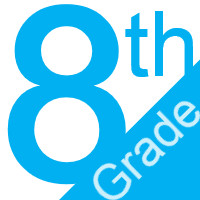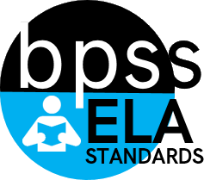ELA-08.SL.01
|
8th Grade ELA Targeted Standards
(SL) Speaking and Listening Strand
Cluster: Comprehension and Collaboration
ELA-08.SL.01 Engage effectively in a range of collaborative discussions (one-on-one, in groups, and teacher-led) with diverse partners on grade 8 topics, texts, and issues, building on others’ ideas and expressing their own clearly.
- a. Come to discussions prepared, having read or researched material under study; explicitly draw on that preparation by referring to evidence on the topic, text, or issue to probe and reflect on ideas under discussion.
- b. Follow rules for collegial discussions and decision-making, track progress toward specific goals and deadlines, and define individual roles as needed.
- c. Pose questions that connect the ideas of several speakers and elicit elaboration, and respond to others’ questions and comments with relevant evidence, observations, and ideas.
- d. Acknowledge new information expressed by others, and, when warranted, qualify or justify their own views and understanding in light of the evidence presented.
|
Student Learning Targets for Grade 8 ELA:
Knowledge Targets
- I can define individual roles for classroom discussions as well as for decision-making groups as needed.
Reasoning Targets
- I can connect and question the ideas of several speakers and respond with relevant evidence, observations, and ideas.
- I can ask relevant questions that move discussion forward.
Skills (Performance) Targets
- I can closely read a text and prepare annotations/notes from my reading that will contribute to discussion.
- I can explicitly draw on my preparation by referring to evidence on the topic, text, or issue to probe and reflect on ideas under discussion.
- I can follow rules for discussions and decision-making.
- I can track progress toward specific goals and deadlines.
- I can acknowledge new information expressed by others, and, if needed, defend their own views in light of the evidence presented.
Product Targets
- I can generate discussion by actively participating.
Student Learning Targets for Grade 8 Reading Pro:
Skills (Performance) Targets
- I can engage in a group discussion with classmates.
- I can engage in a teacher-led group discussions with diverse partners on grade 8 topics
- I can engage in discussion on grade 8 topics, texts, and issues building on others' ideas and expressing their own clearly.
Proficiency Scale for Grade 8 ELA:
| Score |
|
8.SL.01 Engage effectively in a range of collaborative discussions (one-on-one, in groups, and teacher-led) with diverse partners on grade 8 topics, texts, and issues, building on others’ ideas and expressing their own clearly. |
Sample Activity
|
| 4.0 |
In addition to Score 3.0, the student demonstrates in-depth inferences and applications regarding more complex material that go beyond end of instruction expectations. |
- |
| |
3.5 |
In addition to Score 3.0 performance, the student demonstrates in-depth inferences and applications regarding the more complex content with partial success. |
| 3.0 |
“The Standard.” The student demonstrates no major errors or omissions regarding any of the information and processes that were end of instruction expectations.
The student will:
- come to discussions prepared (evidence: close read, notes/annotations, questions and comments of the text).
- explicitly draw on that preparation by referring to evidence on the topic, text, or issue to probe and reflect on ideas under discussion.
- follow rules for discussions and decision-making.
- track progress toward specific goals and deadlines.
- connect and question the ideas of several speakers and respond with relevant evidence, observations, and ideas.
- acknowledge new information expressed by others, and, if needed, defend his or her own views in light of the evidence presented.
|
- |
| |
2.5 |
The student demonstrates no major errors or omissions regarding the simpler details and processes (Score 2.0 content) and partial knowledge of the more complex ideas and processes (Score 3.0 content). |
| 2.0 |
The student demonstrates no major errors or omissions regarding the simpler details and processes but exhibits major errors or omissions regarding the more complex ideas and processes (Score 3.0 content).The student will:
- define individual roles of problem-solving groups or classroom discussion as needed.
- come to discussions partially prepared; and/or does not explicitly draw on that preparation by referring to evidence on the topic, text, or issue to probe and reflect on ideas under discussion.
- follow most rules for discussions and decision-making, attempts track progress toward specific goals and deadlines, and define individual roles as needed.
- loosely connects and questions the ideas of several speakers and respond with relevant evidence, observations, and ideas.
- acknowledge new information expressed by others, but defends his or her own views with limited evidence in light of the evidence presented.
|
- |
| |
1.5 |
The student demonstrates partial knowledge of the simpler details and processes (Score 2.0 content) but exhibits major errors or omissions regarding the more complex ideas and procedures (Score 3.0 content). |
| 1.0 |
With help, the student demonstrates a partial understanding of some of the simpler details and processes (Score 2.0 content) and some of the more complex ideas and processes (Score 3.0 content). |
- |
| |
0.5 |
With help, the student demonstrates a partial understanding of some of the simpler details and processes (Score 2.0 content) but not the more complex ideas and processes (Score 3.0 content). |
Proficiency Scale for Grade 8 Reading Pro:
| Score |
|
8.SL.01 Engage effectively in a range of collaborative discussions (one-on-one, in groups, and teacher-led) with diverse partners on grade 8 topics, texts, and issues, building on others’ ideas and expressing their own clearly.
a. Come to discussions prepared, having read or researched material under study; explicitly draw on that preparation by referring to evidence on the topic, text, or issue to probe and reflect on ideas under discussion.
|
Sample Activity
|
| 4.0 |
In addition to Score 3.0, the student demonstrates in-depth inferences and applications regarding more complex material that go beyond end of instruction expectations. |
- |
| |
3.5 |
In addition to Score 3.0 performance, the student demonstrates in-depth inferences and applications regarding the more complex content with partial success. |
| 3.0 |
“The Standard.” The student demonstrates no major errors or omissions regarding any of the information and processes that were end of instruction expectations.The student comes to discussions prepared, having read or studied required material:
- Shows notes/annotation of text as evidence of preparation.
- During discussion, uses textual evidence to support ideas.
- Verbally gives input at all levels of discussion, in small group, large group, whole group.
- Asks and answers questions of the text.
Within discussion, the student exhibits no major errors or omissions regarding an understanding of the text. |
- |
| |
2.5 |
The student demonstrates no major errors or omissions regarding the simpler details and processes (Score 2.0 content) and partial knowledge of the more complex ideas and processes (Score 3.0 content). |
| 2.0 |
Within discussion, student reveals no major errors or omissions regarding the simpler details of the text as the student:
- shows verbal evidence of reading, but has not prepared for discussion beyond reading
- supports some ideas with textual evidence, but not consistently
- provides input in some levels of discussion, but not with whole group
- answers some questions posed from the group, but does not ask questions that help advance discussion.
However, the student exhibits major errors or omissions regarding the more complex ideas and concepts of text. |
- |
| |
1.5 |
The student demonstrates partial knowledge of the simpler details and processes (Score 2.0 content) but exhibits major errors or omissions regarding the more complex ideas and procedures (Score 3.0 content). |
| 1.0 |
With help, the student demonstrates a partial understanding of some of the simpler details and processes (Score 2.0 content) and some of the more complex ideas and processes (Score 3.0 content). |
- |
| |
0.5 |
With help, the student demonstrates a partial understanding of some of the simpler details and processes (Score 2.0 content) but not the more complex ideas and processes (Score 3.0 content). |
Resources
Websites
- Add resources with links, youtube or PDF
Vocabulary
|
 Standards Glossaries
Standards Glossaries Standards Glossaries
Standards Glossaries Standards Glossaries
Standards Glossaries Standards Glossaries
Standards Glossaries Standards Glossaries
Standards Glossaries


 Strand (SL)
Strand (SL)